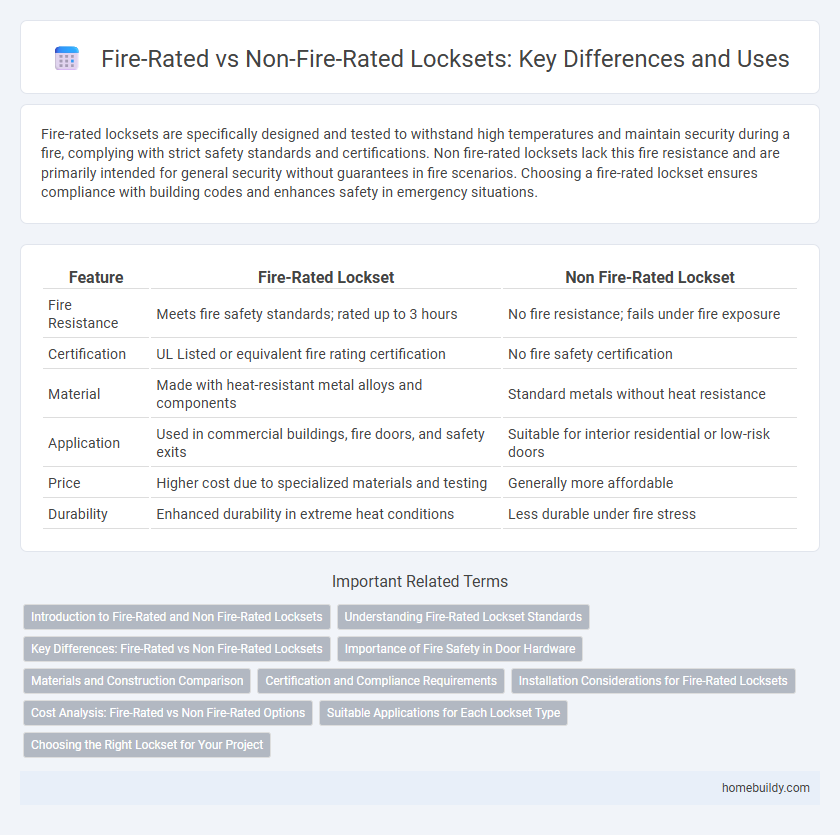Fire-rated locksets are specifically designed and tested to withstand high temperatures and maintain security during a fire, complying with strict safety standards and certifications. Non fire-rated locksets lack this fire resistance and are primarily intended for general security without guarantees in fire scenarios. Choosing a fire-rated lockset ensures compliance with building codes and enhances safety in emergency situations.
Table of Comparison
| Feature | Fire-Rated Lockset | Non Fire-Rated Lockset |
|---|---|---|
| Fire Resistance | Meets fire safety standards; rated up to 3 hours | No fire resistance; fails under fire exposure |
| Certification | UL Listed or equivalent fire rating certification | No fire safety certification |
| Material | Made with heat-resistant metal alloys and components | Standard metals without heat resistance |
| Application | Used in commercial buildings, fire doors, and safety exits | Suitable for interior residential or low-risk doors |
| Price | Higher cost due to specialized materials and testing | Generally more affordable |
| Durability | Enhanced durability in extreme heat conditions | Less durable under fire stress |
Introduction to Fire-Rated and Non Fire-Rated Locksets
Fire-rated locksets are engineered to withstand high temperatures and maintain security during fire incidents, meeting strict building code requirements for fire safety. Non fire-rated locksets, while suitable for everyday security needs, lack the tested resistance to intense heat and smoke, making them insufficient for fire-rated doors. Selecting a fire-rated lockset ensures compliance with fire safety standards and enhances occupant protection in emergency situations.
Understanding Fire-Rated Lockset Standards
Fire-rated locksets comply with rigorous safety standards such as UL 10C and NFPA 80, ensuring they withstand high temperatures and prevent smoke infiltration during fires. These locksets are tested for specific fire ratings, typically ranging from 20 to 90 minutes, to maintain door integrity in emergency situations. Non fire-rated locksets lack such certifications and do not provide guaranteed protection against fire or smoke, making them unsuitable for fire-rated doors in commercial or residential buildings.
Key Differences: Fire-Rated vs Non Fire-Rated Locksets
Fire-rated locksets are designed to withstand high temperatures and maintain door integrity during fires, meeting specific fire safety standards such as UL 10C or NFPA 80, while non-fire-rated locksets lack these certifications and fire resistance capabilities. Fire-rated locksets incorporate materials like steel or brass and enhanced mechanisms to ensure functionality under extreme heat, whereas non-fire-rated locksets prioritize aesthetics and general security without testing for fire scenarios. The key differences lie in their fire resistance duration, compliance with safety codes, and application in fire door assemblies critical for building safety protocols.
Importance of Fire Safety in Door Hardware
Fire-rated locksets are engineered to maintain door integrity and contain fire and smoke, meeting strict safety standards like UL 10C and NFPA 80, unlike non fire-rated locksets that lack these critical certifications. Installing fire-rated locksets is essential in commercial and residential buildings to enhance occupant protection and comply with local fire codes. Prioritizing fire safety in door hardware minimizes property damage and saves lives by ensuring doors function effectively during emergency evacuations.
Materials and Construction Comparison
Fire-rated locksets feature durable materials such as stainless steel or heavy-duty brass and incorporate reinforced internal components to withstand high temperatures and prevent smoke penetration during fires. Non fire-rated locksets typically use standard alloys and lighter construction designed primarily for everyday security rather than thermal resistance. The enhanced construction of fire-rated locksets includes fire-resistant coatings and seals that maintain door integrity, contrasting with the basic mechanical design of non fire-rated options.
Certification and Compliance Requirements
Fire-rated locksets must comply with strict certification standards such as UL 10C and ANSI/BHMA A156.2, which ensure they can withstand high temperatures and maintain door integrity during fire emergencies. Non fire-rated locksets lack these certifications and are not tested for fire resistance, making them unsuitable for life safety applications in fire-rated doors. Compliance with local building codes typically mandates the use of fire-rated locksets in exit routes and fire barrier doors to enhance occupant safety.
Installation Considerations for Fire-Rated Locksets
Fire-rated locksets require precise installation to maintain the door's fire-resistance rating, typically involving fire-rated doors and frames compliant with standards like UL 10C or NFPA 80. Installers must ensure proper gasket placement, compatibility with fire-rated hardware, and adherence to manufacturer specifications to prevent compromising fire protection. Non fire-rated locksets do not demand such stringent criteria, making fire-rated options more complex but essential for life safety in commercial and institutional buildings.
Cost Analysis: Fire-Rated vs Non Fire-Rated Options
Fire-rated locksets generally cost between $70 and $200, reflecting their enhanced durability and compliance with safety regulations in commercial buildings and fire code requirements. Non fire-rated locksets are more affordable, typically ranging from $20 to $80, but lack the certified resistance to fire and smoke penetration. When analyzing cost, investing in fire-rated locksets proves economically sensible for meeting safety standards and reducing potential liabilities in high-risk environments.
Suitable Applications for Each Lockset Type
Fire-rated locksets are suitable for commercial buildings, hospitals, and schools where compliance with fire safety codes and protection against fire hazards is mandatory. Non fire-rated locksets are ideal for residential properties, interior doors, and low-risk environments where fire resistance is not a critical requirement. Choosing the appropriate lockset depends on building regulations, occupancy type, and required safety standards.
Choosing the Right Lockset for Your Project
Fire-rated locksets are specifically designed to withstand high temperatures and prevent the spread of fire and smoke, making them essential for commercial buildings and areas with strict fire safety codes. Non fire-rated locksets, while suitable for residential and low-risk environments, lack the durability and certification required for fire-rated applications. Selecting the right lockset depends on the building's fire safety requirements, legal regulations, and the need for enhanced protection during emergencies.
Fire-rated lockset vs Non fire-rated lockset Infographic

 homebuildy.com
homebuildy.com